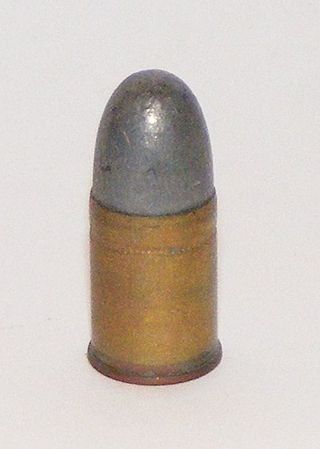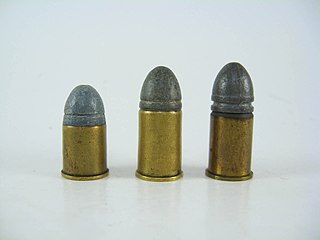
The Webley Revolver was, in various designations, a standard issue service revolver for the armed forces of the United Kingdom, and countries of the British Empire and the Commonwealth of Nations, from 1887 to 1963.

Webley & Scott is an arms manufacturer founded in Birmingham, England. Webley produced handguns and long guns from 1834 to 1979, when the company ceased to manufacture firearms and instead turned its attention to producing air pistols and air rifles. In 2010 Webley & Scott restarted the production of shotguns for commercial sale.

The .38 S&W, also commonly known as .38 S&W Short, 9×20mmR, .38 Colt NP , or .38/200, is a revolver cartridge developed by Smith & Wesson in 1877. Versions of the cartridge were the standard revolver cartridges of the British military from 1922 to 1963. Though similar in name, it is not interchangeable with the later .38 Special due to a different case shape and slightly larger bullet diameter.

This is a list of firearm cartridges which have bullets in the 11 millimetres (0.43 in) to 11.99 millimetres (0.472 in) caliber range.

The .22 Remington Jet (5.6x33mmR) is a .22 in (5.6mm) American centerfire revolver and rifle cartridge. The round is known in the US as .22 Jet, .22 Center Fire Magnum/.22 CFM or .22 Rem Jet.

.455 Webley is a British handgun cartridge, most commonly used in the Webley top break revolvers Marks I through VI. It is also known as ".455 Eley" and ".455 Colt".

The Enfield Revolver was a self-extracting British handgun designed and manufactured at the government-owned Royal Small Arms Factory in Enfield, initially in the .476 calibre.

The Beaumont–Adams revolver is a black powder, double-action, percussion revolver. Originally adopted by the British Army in .442 calibre in 1856, it was replaced in British service in 1880 by the .476 calibre Enfield Mk I revolver.

An antique firearm is a term used to describe a firearm that was designed and manufactured prior to the beginning of the 20th century. Although the exact definition of what constitutes an "antique firearm" varies between countries, the advent of smokeless powder or the start of the Boer War are often used as cut-off dates. Antique firearms are usually collected because of their historical interest and/or their monetary value.

The .32 Long Colt is an American centerfire revolver cartridge.

The Colt New Service is a large frame, large caliber, double-action revolver made by Colt from 1898 until 1941. Made in various calibers, the .45 Colt version with a 5½" barrel, was adopted by the U.S. Armed Forces as the Model 1909.
The .50-110 WCF / 13x61mmR in modern 1886 Winchesters with modern steel barrels is the most powerful lever-action cartridge, with up to 6,000 foot-pounds (8,100 J) of energy.

The .44 S&W American / 11x23mmR is an American centerfire revolver cartridge.

The .44 Colt / 11.5x28mmR is an American centerfire revolver cartridge that was produced commercially from 1871 to 1940.

The .22 Extra Long is a .22 in (5.6 mm) American rimfire rifle and handgun cartridge.

The .450 Adams was a British black powder centrefire revolver cartridge, initially used in converted Beaumont–Adams revolvers, in the late 1860s. Officially designated .450 Boxer Mk I, and also known variously as the .450 Revolver, .450 Colt, .450 Short, .450 Corto, and .450 Mark III, and in America as the .45 Webley, it was the British Army's first centrefire revolver round.

The .442 Webley is a British centrefire revolver cartridge.

The .44 Bull Dog was an American centerfire revolver cartridge produced from the 1880s until the 1930s.
The .25 Stevens / 6.4x28mmRF was an American rimfire rifle cartridge. To differentiate from the related .25 Stevens Short it is sometimes also referred to as .25 Stevens Long.

The Enfield No. 2 was a British top-break revolver using the .38 S&W round manufactured from 1930 to 1957. It was the standard British/Commonwealth sidearm in the Second World War, alongside the Webley Mk IV and Smith & Wesson Victory Model revolvers chambered in the same calibre. Note that in the context of British service revolvers, the .38 S&W cartridge has often been called ".380".

















